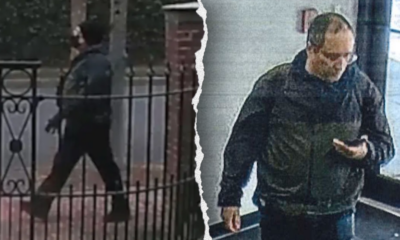Entertainment
'Days of Our Lives' veteran Drake Hogestyn dies at 70

Drake Hogestyn, who played mysterious and heroic John Black on “Days of Our Lives” for nearly four decades, died Saturday morning. He was 70.
The actor, who lived in Los Angeles and died one day shy of his 71st birthday, had been battling pancreatic cancer. His family announced news of his passing in a statement posted to the Instagram account of the long-running soap opera.
“After putting up an unbelievable fight, he passed peacefully surrounded by loved ones,” part of the statement read. “He was the most amazing husband, father, papa and actor. He loved performing for the ‘Days’ audience and sharing the stage with the greatest cast, crew, and production team in the business. We love him and we will miss him all the Days of our Lives.”
Born Sept. 29, 1953, in Fort Wayne, Ind., Hogestyn’s early onscreen work included TV series “Seven Brides for Seven Brothers” and TV films such as “Generation” and “Beverly Hills Cowgirl Blues.”
He first appeared on “Days of Our Lives” on Jan. 24, 1986, and went on to establish a long running arc as one of the daytime soap’s most popular characters. As John Black, across more than 4,200 episodes, Hogestyn was a spy, mercenary, police officer, private investigator and secret agent. Along the way, he’s been shot, stabbed, paralyzed, ejected from a submarine, trapped in a gas chamber, stalked by a serial killer, attacked by Satan, and has effortlessly come back to life after being dead — all while his signature eyebrow arch reacted to the chaos accordingly.
Drake Hogestyn and Deidre Hall in “Days of Our Lives.”
(JPI / Days of Our Lives)
And with Diedre Hall as Marlena Evans, Hogestyn helped create one of daytime TV’s most beloved romances, known affectionately as Jarlena.
Hogestyn’s former castmate Alison Sweeney, who played Sami Brady on the soap, was one of his “Days of Our Lives” family members who paid tribute to the late actor on social media.
“Drake was an incredible man,” she wrote. “He was funny, generous and thoughtful. He cared about every single scene, every person. He loved Days, the fans, and shared that passion with everyone on set.”
Kristin Alfonso, known for playing Hope Brady on the soap, praised Hogestyn as a “loving father, husband, and Dear friend” [sic].
He is survived by his wife Victoria Post, as well as their four children and seven grandchildren.

Movie Reviews
Movie Review 2025 with 11 Films of the Year
Image: Wicked: For Good – Movie Poster
Another year is drawing to a close, and it’s time for our cinema review! In 2025, we saw many franchises return to the big screen, along with sequels to cult classics and new adaptations of legendary stories. From sci-fi and horror to musical adaptations, a wide range of genres offered fresh releases. Whether all of it was truly great is for everyone to decide individually – here is our trailer recap!
While Disney continues to push its live-action remake strategy (Snow White, Lilo & Stitch), Pixar at least delivered a brand-new animated feature with Elio.
When it comes to video game adaptations, several titles were released this year – most notably the Minecraft adaption A Minecraft Movie starring Jack Black and Jason Momoa, the second installment of Five Nights at Freddy’s, and the Until Dawn film, which was heavily criticized by the community.
In Germany, Bully Herbig delivered a sequel to his comedy Der Schuh des Manitu with Das Kanu des Manitu, bringing the characters from one of his most successful films back to the big screen.
Just before Christmas, James Cameron launched the third part of his hit film series Avatar. Sequels also arrived for Jurassic World, the DCU, the Conjuring universe, and the popular animated film Zootopia.
Director Guillermo del Toro took on a new adaptation of the absolute sci-fi horror cult classic and novel by Mary Shelley: Frankenstein has now been brought back to life by the creator of films such as Pacific Rim and The Shape of Water.
When it comes to adaptations, arguably the most popular musical of the year: with Part 2, the Wicked hype has returned once again.
Entertainment
Why Gen Z and Gen Alpha are feasting on TV comfort food

John Campbell is a senior vice president at Walt Disney Co. who oversees streaming ad sales solutions. He also coaches his second-grade daughter’s basketball team, and recently asked her teammates to name their favorite TV show.
“Eleven out of 13 girls said ‘Hannah Montana,’ ” Campbell said in a recent interview, citing the popular Disney series starring Miley Cyrus that produced its last episode in 2011, before any of his players were born.
Campbell was pleased they selected a show from the Disney library, but wasn’t all that surprised based on the advertising demand he’s seeing for the company’s vintage shows.
A recent study from National Research Group found that 60% of all TV consumed is library content. Among Gen Z, 40% say they watch older shows because they find them comforting and nostalgic. Disney’s own research finds that 25% of the programs kids call their favorites were made before 2010.
While newer cutting-edge series typically win critical kudos and accolades, Gen Z and Gen Alpha viewers are binge-watching programs that became hits on the broadcast and cable networks in the pre-streaming era. They are also devouring holiday movies and specials, even on traditional TV.
“We do see, especially around the holiday time, that people are looking for that comfort, that sense of ease,” Campbell said.
As more TV ad spending moves from traditional networks to streaming, Campbell said Disney is capitalizing on the retro trend thanks to its massive library of series. The company has seen the Gen Z audiences devour hits of yesteryear such as “How I Met Your Mother,” “Modern Family” and “Golden Girls.”
Miley Cyrus and Emily Osment in Disney’s “Hannah Montana.”
(Joel Warren/2006 Disney Channel)
“Scrubs” and “Malcolm in the Middle” are such strong performers on Hulu and Disney+, the company has ordered reboots that advertisers are eager to be a part of, according to Campbell. Disney has even worked with advertisers to make throwback commercials to run in classic films on its streaming platforms and TV networks.
“The younger audience is drawn to the perceived simplicity of the old times and humor,” Kavita Vazirani, executive vice president of research, insights and analytics, ABC News Group & Disney Entertainment Networks. “It’s programming that just makes them feel good, and it’s something that they can watch with their friends, their families.”
Older shows have long had a place among young viewers. Previous generations grew up watching reruns of “The Brady Bunch” and “I Love Lucy” after school, when their choices on broadcast TV were scant.
But the current viewer has an endless plethora of viewing choices through streaming and cable. One executive at another media company not authorized to comment publicly cited research that said teens and young adults are gravitating to the more conventional sitcoms and dramas from the early 2000s, believing they were made explicitly for their age group.
During the era, the WB Network — later merged into the CW — was turning out young adult dramas such as “The Gilmore Girls” and “Dawson’s Creek,” while the Disney Channel was at the height of its popularity. “Friends,” the idealized rendering of urban life for young adults and long a favorite on streaming, was the ratings leader at the time.
The appetite for such programs showed up in the most recent “Teens and Screens” study by the Center for Scholars & Storytellers @ UCLA found that among the 10- to 24 year-olds, 32.7% said they want to see “relatable stories that are like my personal life.” The previous year, the top answer was fantasy, which ranked second in 2025.
But another reason young viewers are digging into the vaults is volume.
The UCLA survey showed that the favorite show among the measured age group is the Netflix series “Stranger Things.” The series has only 42 episodes over five small-batch seasons.
When a young viewer finds an older successful series that ran on a network for years when 22 episodes per season was standard, they can binge for hundreds of hours.
“There are a lot of seasons of available episodes that you can watch, in typically any random order you want to,” said Nii Mantse Addy, chief marketing officer at the streaming service Philo, which also has seen a sharp rise in viewing of library programs.
“There’s not as much decision fatigue,” Addy said. “The shows provide something that you can go back to and just turn on and know kind of how it’s going to make you feel.”
Executives also say that binge-watching old shows provides a respite from the angst young people experience while scrolling through social media, which escalated through the COVID-19 lockdowns.
But social media have also been a tool to help consumers discover new programs. Fans of vintage series post TikTok videos reacting to episodes that first aired years ago. There are also fan communities online and “re-watch” podcasts that are driving people to seek out programs.
“Social media has been quite a catalyst for essentially introducing these old shows to a whole new audience, whether it’s through memes, viral clips or whatever it may be,” Vazirani said. “It’s like the modern day water cooler, essentially.”
Movie Reviews
Movie Review – The Testament of Ann Lee (2025)

The Testament of Ann Lee, 2025.
Directed by Mona Fastvold.
Starring Amanda Seyfried, Lewis Pullman, Thomasin McKenzie, Matthew Beard, Christopher Abbott, David Cale, Stacy Martin, Scott Handy, Jeremy Wheeler, Tim Blake Nelson, Daniel Blumberg, Jamie Bogyo, Viola Prettejohn, Natalie Shinnick, Shannon Woodward, Millie-Rose Crossley, Willem van der Vegt, Esmee Hewett, Harry Conway, Benjamin Bagota, Maria Sand, Scott Alexander Young, Matti Boustedt, George Taylor, Alexis Latham, Lark White, Viktória Dányi, and Roy McCrerey.
SYNOPSIS:
Ann Lee, the founding leader of the Shaker Movement, proclaimed as the female Christ by her followers. Depicts her establishment of a utopian society and the Shakers’ worship through song and dance, based on real events.
The second coming of Christ was a woman. Narrated as a story of legend and constructed as a cinematic epic, co-writer/director Mona Fastvold’s The Testament of Ann Lee tells the story of the eponymous 18th-century preacher who occasionally experienced divine visions guiding her on how to teach her and her followers to free themselves and be absolved of sin.
This group, an offshoot of Quakers known as Shakers, did so by stimulating and intoxicating full-body rhythmic dancing movements set to many hymns beautifully sung by Amanda Seyfried and others. The key distinction between the group, and arguably the toughest selling point of the film aside from the religious nature of it all, is that Ann Lee asserted that the only way to achieve such pure holiness is by giving up all sexual relations, living a life of celibacy (as evident by some laughter during the CIFF festival screening when she made this decree, which quickly subsided as it is relatively easy to buy into her mission and convictions).
It shouldn’t necessarily come as a surprise that Mona Fastvold had trouble getting this one off the ground. Perhaps what finally secured the project’s financial backing was all those awards The Brutalist (directed by her husband Brady Corbet and co-written by her, flipping those duties and credits this time around) either won or was nominated for, which was notably another film that almost no one had interest in making. The point is that this should serve as a reminder that there is an audience for anything and everything.
Whether one doesn’t care about religious movements or is a nonbeliever, The Testament of Ann Lee is remarkably hypnotic in its craftsmanship. It features a flat-out career-best performance from Amanda Seyfried, who blends all of her strengths as an actor and unleashes them at the peak of her talent. Yes, there are moments of tragedy and trauma, but the film refuses to wallow in misery, chartering her Shakers movement with hope, miracles, and perseverance as the journey takes them from Manchester to Niskayuna, New York, in search of expanding their follower base while dealing with other setbacks within the movement and personally.
Chronicling Ann Lee’s life with precise editing that rarely drags (and mostly fixates on the early stages of the Shakers movement and decade-plus long attempt to battle sexism as a female preacher and find a foothold amidst escalating tensions between British and Americans), the film also offers insight into the events that gave her a repulsion for sexual intimacy, her marriage with blacksmith Abraham (Christopher Abbott), and dynamics with her most loyal supporters which includes brother William (Lewis Pullman) and Mary (Thomasin Mckenzie, also serving as the narrator). Given the unfortunate nature of how most women, especially wives, were expected to have zero agency compared to their male counterparts and deliver babies, it is also organically inspiring watching her find a group with similar beliefs willing to trust her visions and take up celibacy. Whether or not all of them succeed is part of the journey and, interestingly enough, shows who is genuinely loyal and in her corner.
This is no dry biopic, though. Instead, it is brimming with life and energy, mainly through those “shaking” sequences depicting those outstandingly choreographed seizure-like dance numbers (typically shot by William Rexer from an elevated overhead angle, looking down at an entire room, capturing a ridiculous amount of motions all weaving together and creating something uniformly spellbinding). The songs throughout are divinely performed, adding another layer to this film’s transfixing pull. Nearly every image is sublime, right up until the perfect final shot. Admittedly, the film loses a bit of steam in the third act as one awaits a grim confrontation with naysayers who feel threatened by her position, movement, and pacifism regarding the burgeoning American Revolution.
Still, whatever reservations one has about watching a religious movement preaching peace and celibacy while laboring away building a utopia (an aspect that puts it in great juxtaposition with The Brutalist) will wash away like sin. That’s the power of the movies; even someone who isn’t religious will find it hard not to be swept up in Ann Lee’s life. Fact, fiction, bluff… it doesn’t matter; the material is treated with conviction and non-judgmental respect. In The Testament of Ann Lee, Amanda Seyfried channels that for something holy, empowering, infectious, and all around breathtaking.
Flickering Myth Rating – Film: ★ ★ ★ ★ / Movie: ★ ★ ★ ★
Robert Kojder
https://www.youtube.com/watch?v=embed/playlist
-

 Iowa1 week ago
Iowa1 week agoAddy Brown motivated to step up in Audi Crooks’ absence vs. UNI
-

 Maine1 week ago
Maine1 week agoElementary-aged student killed in school bus crash in southern Maine
-

 Maryland1 week ago
Maryland1 week agoFrigid temperatures to start the week in Maryland
-

 New Mexico7 days ago
New Mexico7 days agoFamily clarifies why they believe missing New Mexico man is dead
-

 South Dakota1 week ago
South Dakota1 week agoNature: Snow in South Dakota
-

 Detroit, MI1 week ago
Detroit, MI1 week ago‘Love being a pedo’: Metro Detroit doctor, attorney, therapist accused in web of child porn chats
-

 Health1 week ago
Health1 week ago‘Aggressive’ new flu variant sweeps globe as doctors warn of severe symptoms
-

 Maine7 days ago
Maine7 days agoFamily in Maine host food pantry for deer | Hand Off

















